
This is the question that the FSOC and SEC have been asking about Money Market Funds ever since 2008! The question is whether they have come up with constructive changes, or "not so constructive" changes!!
What very recent business news story links the following themes:
1) The 1976 suspense/thriller film, “Marathon Man”;

"MARATHON MAN" is a suspense/thriller that you should not watch just prior to visiting your dentist!
2) The most repeated line spoken by Laurence Olivier’s character, Dr. Zell: “Is it safe?”

Laurence Olivier did a superb job of bringing this completely ruthless and scary WW II era doctor to life!
3) The FSOC[1]; and
4) The financial tool created by Bruce R. Bent in October of 1971?
Answer: By a 3-2 vote[2] on July 23rd, the U.S. Securities and Exchange Commission (SEC) agreed to amend existing Federal rules regulating “Money Market Funds”.
[IMPORTANT BONUS QUESTION: See Footnote 3. [3] ]
Let me briefly summarize the essence of these amendments:
I) Requires Money Market Fund providers to establish a floating net asset value (NAV) for institutional “prime” money market funds[4].
A. This means that these “prime funds” will no longer carry a constant one-dollar share value;
B. Instead, the share price will fluctuate, in order to accurately reflect the aggregate changes in the market-based value of all the securities held by each fund
II) The rule will also provide “non-Government” Money Market Funds with “new tools” to address periods when liquidity is tight (such as it was in 2008).
A. Those “tools” are referred to as “Fees and Gates” [real helpful, eh? Remember, the SEC is a government body – and they prefer “government speak” to English.]
1) The “Gates” are actually “Redemption Gates”
a) During a future “Liquidity Event” [Lehman Brothers’ bankruptcy was a “Liquidity Event”] these money funds can temporarily suspend redemptions.
b) Such a “Gate” should only be imposed if/when a fund’s (weekly liquid assets fall below30% of its total assets… and even then, only if the fund’s Board determines that a suspension is in the “best interests of the fund.”
c) Any such “Gate” must be lifted within 10 business days; no fund will be permitted to impose a “Gate” for longer than 10 days within any 90-day period.
2) The “Fees” are really “Liquidity Fees”.
a) Once again, if/when a fund’s weekly liquidity ratio(s) falls below the level required by regulations, a fund’s Board may impose a “liquidity fee” on any redemptions requested.
b) The fee may be as high as two percent (with the goal of discouraging redemptions).
c) If a fund’s liquidity falls below 10%, a 1% fee must be charged (unless board members determine “that such a fee is not in the best interests of the fund… or that a lower or higher liquidity fee is in the best interests of the fund.”[5])
B. One revelation that I uncovered during my standard research was how misleading the typical “mainline” story on this SEC action has been.
1) The first five or six articles I read led me to assume that the average “Retail” money market fund[6] would not be impacted.
2) Alas, the next few articles I read disabused me of that assumption!
3) The fact is that Retail funds could very possibly be impacted by “Fees” and “Gates” rules … depending upon their liquidity ratios, the condition of the entire U.S. financial system, and the judgment of their governing boards!
4) Put simply:
a) Retail funds will not be required to carry a “Floating Net Asset Value” (that only applies to the “Prime” or institutional funds!).
b) However, if/when a retail fund’s weekly liquid assets fall below 30% of its total assets… that fund’s Board will be allowed to impose “Fees and/or Gates” if that Board determines that such an action will be in the “best interests of the fund
I’ve known that the regulation of Money Market Funds has been on the “top burner” of the SEC ever since 2008. They did institute fairly extensive rule changes to Rule 2a-7 in 2010, but soon thereafter realized that more “tweaking” was needed. And as we will learn later, a more expansive version of the amendments above were widely “floated” in 2012. However, that 2012 proposal was roundly and effectively fought by the fund industry (and at least 3 of the SEC commissioners at that time). At that point, the FSOC[7] put its foot down[8] and made it crystal clear to current SEC Chair, Mary Jo White, that unless she pushed through appropriate amendments soon, the FSOC would “take over”. I guess that is what passes for “interagency cooperation” and understanding these days!
All of this will (hopefully) make more sense once I provide some background history regarding money funds:
October of 1971 witnessed the inauguration of a totally new type of mutual fund – a fund specifically designed to enable any investor (big or small) to latch onto a diversified portfolio of very short-term fixed income securities. That fund offered convenient access to “Money Market” rates[9].
This first Money Market Fund was launched by Bruce R. Bent (and a partner) and called The Reserve Fund. Bent considered his fund a “stable-value” product[10] that would allow investors to “sleep at night”.
As investors became familiar with this concept and learned to trust the product’s viability and dependability, the fund grew. Then of course, as we would expect, other financial firms started to launch their own money funds… including the addition of an option to redeem shares via a check (almost always requiring a check size of at least $500).
Then a “rocket booster” developed for these funds – a “perfect storm” of bad financial news:
1) A 40% stock market decline in 18 months,
2) a weak economy,
3) rising unemployment,
4) an accommodative Federal Reserve, and
5) burgeoning inflation![11]
To combat this vicious cycle, Paul Volcker was appointed as Chair of the Federal Reserve and began to raise rates. As we know from Econ 101, money seeks out the highest risk-adjusted investment return available; therefore, assets invested in this “sleep at night” investment option ballooned!![12]
By August of 1997, total assets invested in U.S. money market funds pushed over the $1 trillion barrier. In just over 4 more years, total assets surged to over $2 trillion![13]
Many considered this asset class to be the “perfect” short-term investment:
1) it provided a dependable, stable $1/share value;
2) it offered an interest rate higher than was available through the “bank version” of the product; and
3) there had been (to date) no instance of “fund failure”.
The first users of these funds were predominantly average “retail” customers (ie. folks like you and me). However, the appeal of money market funds was not lost on corporate treasurers and other “institutions” (such as pension funds). In recent years, the aggregate balance in institutional fund accounts far surpassed the total balances on the “retail” side!
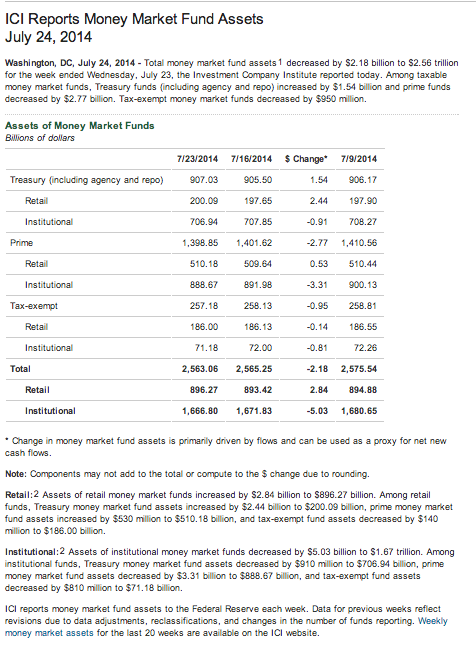
If you look at the "totals" at the bottom of the page, you'll see that Institutional Funds hold twice as many assets as on the Retail side.
As we know, the entire financial system was shaken by the vicious cycle of “black swan” events during the 2007-09 period – highlighted by the failure of Lehman Brothers and the blowup within the “subprime mortgage securities” space.[14]
Mr. Bent’s “grand daddy of them all” money market fund (retitled as the “Reserve Primary Fund” by 2008) had the extreme misfortune of holding what was (until the fall of 2008) highly rated securities issued by Lehman Brothers (note that said securities only constituted 1.5% of total assets, so fund managers were utilizing sound risk management)!
Of course, when Lehman quite unexpectedly filed for bankruptcy, and (equally unexpectedly) Lehman was not included in the Federal government’s mega-trillion dollar “rescue plan”[15], the Reserve Primary Fund was suddenly overcome by a massive “liquidity event”! As logic would dictate, the fund’s share price “broke the buck” (NAV fell to $0.97/share) and it was forced to cease operations![16]
Of course, these events led to numerous Congressional investigations, SEC scrutiny, and (more helpfully) a thorough review of fund structure and operations by leaders within the fund industry itself. By January of 2010, the SEC announced amendments to Rule 2a-7. After formally instituting these rule changes, the SEC said (in 2010):
“The SEC’s new rules are intended to increase the resilience of money market funds to economic stresses and reduce the risks of runs on the funds by tightening the maturity and credit quality standards and imposing new liquidity requirements.”
What were primary components of these 2010 changes to Rule 2a-7?
A) Liquidity provisions:
1) Taxable funds required to hold a minimum of 10% of total assets in “daily liquid assets”[17];
2) These funds also had to carry a minimum of 30% of assets in “weekly liquid assets”[18];
B) All money market funds became subject to occasional stress testing.[19]
C) Any such fund’s board may decide to suspend redemption requests if it fears that preserving the stable $1/share price has become precarious.
D) The maximum weighted-average maturity for the entire security portfolio can not exceed 60-days (previously it was 90-days.[20]
E) Additional curbs on repurchase agreements (repos) were introduced.
F) Fund companies were required to supply the SEC (monthly) a report on portfolio composition/details, as well as a market-based value for the fund.
G) Required each fund/fund family to develop (by the end of October of 2011) whatever system was necessary to enable the processing of fund transactions at a “variable price” (ie. above or below $1/share).
I must interject at this point that the SEC did not actually require moving to variable pricing – it merely required funds to create a system that would enable such pricing! However, as far as the fund industry, brokerage houses, financial advisors, and the Chamber of Commerce were concerned, variable pricing was a “non-starter”.
Despite a mountain of opposition from those (well-funded) interests, then SEC chairwoman, Mary Schapiro, was stunningly open about her commitment to not let up the pressure from the SEC to (finally) replace constant net asset value pricing with variable pricing! Why was Schapiro so deadest on variable pricing?
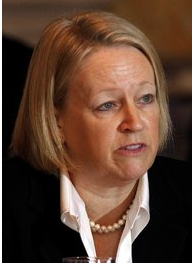
Mary L. Schapiro was Chair of the SEC from 2009 thru 2012. She then moved on to Promontory Financial Group, but to her credit, she refused to represent clients before the government. She earned $3.3 million during her last year as head of the Financial Industry Regulatory Authority (which is aptly titled, since it handles self regulation for the industry) before being named to the SEC.
The best explanation for her bedrock commitment to variable pricing is “human nature” [my explanation, not hers!]:
A) The price for money market funds had been $1/share since Bent first founded his fund in 1971;
B) When banks entered the “money fund” market (with slightly different rules, of course) that really muddied the waters.
C) As money fund users became completely comfortable with using these funds as a secure, dependable “cash tool” … including writing checks on the balance in their account… users began to (incorrectly) associate money market funds with any or all of the following:
1) A bank-like account;
2) “Riskless”
3) FDIC (Federally Insured)
The response to the Reserve Primary Fund “Breaking the Buck” was wickedly and frighteningly massive – redemption requests within the money market space exceeded $300 billion! That “run” was a significant contributor to the “freezing up” or “seizing” of global financial markets. The Federal Reserve, the SEC, and the U.S. Treasury Department were never likely to “forget” that seminal event. It remains a nightmare for them.
Each of those bodies are well aware that the “Prospectus” distributed to all fund buyers of either a Retail and Institutional Money Market Fund goes to great lengths to emphasis that the fund:
1) Invests in securities, repos, and a variety of non-guaranteed fixed income instruments;
2) Therefore, any given investor might lose some principal;
3) Neither the FDIC nor the SEC (nor any government entity) guarantees the principal of a money market fund!
That being said, it is also widely known by the government, by the fund industry, by financial advisers, and by psychologists everywhere that the average person simply does not bother to read (much less firmly integrate) the Prospectus. Therefore, if one was to do a “Pop Quiz” among all fund users… there is a good chance that 50% or more of Retail fund users would “flunk” the quiz!
Needless to say, between “breaking the buck”, Lehman Brothers, and ongoing regulatory tinkering by the SEC, we can see a significant drop off in money fund assets between 2008 and 2013!
In my humble opinion, more troubling than the SEC’s fixation upon the “Money Market Problem” was the heavy handed approach of the FSOC, which not only deemed it appropriate to devise potential “solutions” for the “Problem”[21] … but then clearly made it clear to incoming SEC Chair, Mary Jo White, that if she did not succeed in moving the SEC to an adequate solution as soon as possible, then the FSOC would take matters into its own hands. [That is, the FSOC threatened the SEC.]
I may be the only one who feels this way, but it seems inconsistent and unfair for the FSOC to single out a particular financial product (Money Market Funds) that was fabulously stable and successful for 37 years as though these funds represented some sort of inherently reckless, rogue danger to the country! After all, the simple truth is that the excesses that led to a severely over-leveraged financial system (and Lehman Brothers’ failure) were created by the collective decisions (mistakes) made by government officials (eg. Barney Frank, Alan Greenspan, Bill Clinton, etc.), leaders within major U.S. banks[22], debt rating agencies that “dropped the ball”, and overly aggressive or mismanaged corporations (AIG and GM come to mind).
The Reserve Primary Fund (for example) appears to me to have acted responsibly:
1) It limited its stake in highly rated Lehman Brothers’ securities to just 1.5%;
2) Before it even purchased those bonds, it depended (as always) upon the credit ratings provided by Standard and Poor’s; and
3) It could never have anticipated that if the U.S. government was going to bail out every other major U.S. financial company, that it would simultaneously decide to let Lehman “twist in the wind”.
That has been the only instance of “Breaking the Buck” since Bent founded that first fund in 1971 (43 years ago!). Do you see my point? Might it be that money funds have become a “Straw Dog”?
Consider these facts:
1) Unlike a plethora of banks and other financial-services companies (eg. AIG) in 2008 and thereafter, money market funds did not need to get rid of any toxic assets. The fact was that money fund portfolios were in profoundly better condition than those of big banks; however, a global liquidity crisis prevented the funds from selling assets. Was that the fault of the funds?
2) The reforms instituted in 2010 have strengthened longstanding rules that had worked well since 1971. Those reforms helped funds weather the Greek Debt Crisis, the infamous S&P downgrade of U.S. government debt, and the seemingly nonstop debates U.S. fiscal matters (budget deficits, debt-ceiling limits, sequester, Fiscal Cliff, etc.). In fact assets declined by 10% during the summer of 2011, but the funds met all of their redemption requests without difficulty!
3) As Nancy Prior (the president of “Money Markets” at Fidelity Investments[23]) has observed: “more than 450 banks have failed since the financial crisis began.” Meanwhile, since the 2010 SEC amendments, money funds have been “more resilient”! She feels that further action was not needed.
4) To that precise point, by January of 2013, the money-fund industry itself chose (without any push from government) to publicly report the daily net asset market value of money market funds[24]!
5) Consider the stark contrast between banks and money market funds that is provided for us by Brian Reid (chief economist for the industry group, Investment Company Institute (ICI)[25] :
“Banks have modest amounts of capital, heavy leverage, no explicit liquidity requirements, long-dated, illiquid, nonmarketable loans, with significant credit risk and almost no transparency about their assets and liabilities.” Consequently, such banks are vulnerable to runs by depositors.
On the other hand, money funds “are not leveraged, have requirements to maintain mandated levels of liquidity and hold short-dated liquid, high-quality, marketable securities with minimal credit risk. They publish their portfolios monthly, and they are not guaranteed by the U.S. government.”
I ask you, my faithful readers, which financial institution is a threat to the U.S. financial system?
Are you scratching your head yet? During my considerable reading, I was impressed as much by the thought process of former SEC Commissioner (until 2012), Troy Paredes, as I was by anyone. He asks the fundamental question that every government leader and regulator must ask before taking any action:
“Fundamentally, we have to ask: ‘What are we solving for?’”
That’s why a laser focus is required on data analysis, on existential, real world economics (not “models”), and a “cost vs. benefit analysis” of any given proposed regulation or law.
As Paredes points out: “If you think that what really happened [in 2008] was a massive run from risk, getting rid of the buck doesn’t solve the problem because a run-from-risk isn’t addressed by a floating NAV”[26]. If regulation solves the wrong problem and drives investors into less-regulated products, we will have damaged an enormously effective investment product, incurred substantial costs and created rather than mitigated risk in the financial system.”
I think that Paredes has eloquently expressed the challenge that goes a long way toward differentiating sound, reasoned governance from what we have been witnessing all too often in Washington DC. Despite all of the telling facts you have read in the past ten paragraphs, the FSOC has (in essence) countered by making it clear to Mary Jo White, the SEC, and everyone else watching that: “We don’t care about all of that. We want this matter regulated the way that we want it regulated! And if Ms. White and her fellow commissioners don’t see to that very soon, we will regulate it for them!”[27]
Be that as it may, Mary Jo White has managed to push through the amendments outlined above – a task that was somewhat Herculean, given the powerful opposition it faced.[28]
The bottom line is that, no matter what the public opposition was, the heavy hand (or foot) of the FSOC carried the day! After the amendments passed by a 3-2 vote, White said the following:
[The rules] “will reduce the risk of runs in money market funds and provide important new tools that will help further protect investors and the financial system. Together, this strong reform package will make our markets more resilient and enhance transparency and fairness of these products for America’s investors.”[29]
Of course, what she couldn’t say was: “Thank heavens I pushed this through. It saves me the embarrassment of watching the FSOC storm in and take over!”
INVESTOR TAKEAWAY:
I am always impressed by the subtle differences (and not so subtle) between the media stories I hear or read (on the one hand) and (on the other hand) what would appear to be the “fuller” facts in the light of history and available data. This story could be used as a “case study” to illustrate how important it is to read widely before believing any single account of “how things are”.
That being said, there are some interesting trends in place that have little to do with the political machinations surrounding money market fund regulation… but result directly from the Federal Reserve’s current “Zero Interest Rate Policy” (ZIRP). Much more than any statement made (or action taken) by Mary Jo White, the action of Ben Bernanke years ago in bringing us ZIRP has zapped most of the (former) appeal from money market funds! Just take a look at these current rates from the major funds… most limited to a barely visible .01%:
One particular chart did immediately catch my attention… a list of “Off Shore Funds”:
I want some of that 0.45% yield available investing through the Pound Sterling!
Even the Institutional funds pay more than Retail… but only as high as 0.10%.
Despite these paltry rates, global money fund assets total almost $4.8 trillion:
Given all of the above (and the fact that I can not access an offshore Pound Sterling fund), what have investors done? They have flocked to extremely short duration fixed income instruments, with the current “giant” being the Pimco Enhanced Short Maturity Exchange-Traded Fund (MINT).
An additional wide-range of choices is available through “Ultrashort Bond” funds. Below is just a hint of the range available.
And yes, my readers, you know that I do not and will not recommend any particular investment instrument. That is up to you and your advisor. But be aware (as your advisor will tell you) that the longer the “Duration” is on any given fund, the higher the fund’s risk is to any given hike in interest rates!
DISCLOSURE:
The author does own MINT, as well as a number of retail money market funds. He can only wish that I had access to Ignis Sterling Liquidity – but he doesn’t qualify. Nothing in this article is intended as a recommendation to buy or sell anything. Always consult with your financial advisor regarding changes in your portfolio – either subtractions or additions.
APPENDIX:

This list of FSOC members who attended the May 2014 meeting will give you a good idea of the high level magnitude of this “Super Regulatory” entity.
FOOTNOTES:
[1] Financial Stability Oversight Council: Forbes magazine calls this body: “one of the 2010 Dodd–Frank Wall Street Reform and Consumer Protection Act’s worst creations.” That article is worth reading, because I doubt that many know how ill-defined and staggeringly expansive its charter is. See: http://www.forbes.com/sites/norbertmichel/2014/07/07/dodd-franks-financial-monster-council-the-fsoc/
[2] SEC Commissioners Kara Stein (Democrat) and Michael Piwowar (Republican) accounted for the “No” votes.
[3] When and how did William Devane’s onscreen “persona” morph and mature from the cocky, arrogant, self-centered, disingenuous, lying jerk he played in Marathon Man (not to mention villain in “Knot’s Landing”) to portraying the President of the United States (twice), Attorney General (Robert Kennedy) once, Secretary of State (once), and Secretary of Defense (several times).
[4] Key Point: “Government funds” are exempted from the “floating NAV” rule. The definition of a “Government fund” is one that invests 99.5% of total assets in cash, government securities, or repurchase agreements collateralized by government securities. The rule before 2010 required just 80% of assets invested within those bounds to be accepted as a “Government fund”.
[5] That is certainly clear as a bell. Remember, this is your government at work.
[6] Here is the definition of a “Retail fund”: one owned by “natural persons”!
[7] For a list of official FSCOC member representatives who attended the May, 2014 meeting, see the APPENDIX. It is chaired by U.S. Treasury Secretary Lew and Federal Reserve Chair Janet Yellen is another prominent member.
[8] Or perhaps it is more like a “Hammer”.
[9] The “Money Market” is defined by Investopedia as: “A segment of the financial market in which financial instruments with high liquidity and very short maturities are traded. The money market is used by participants as a means for borrowing and lending in the short term, from several days to just under a year. Money market securities consist of negotiable certificates of deposit (CDs), bankers acceptances, U.S. Treasury bills, commercial paper, municipal notes, federal funds and repurchase agreements (repos).”
[10] “A dollar in… a dollar out… with some interest.”
[11] From Investopedia: This is the gruesome story of the great inflation of the 1970s, which began in late 1972 and didn't end until the early 1980s. In his book, “Stocks for the Long Run: A Guide for Long Term Growth” (1994), Professor Jeremy Sigel, called it “the greatest failure of American macroeconomic policy in the postwar period.”
[12] I recall earning as high as 18% APR on money market funds during part of this era! (a far cry from today’s ZIRP!)
[13] The funds became so popular as early as the 1980’s that banks felt compelled to create their own version of the investment option.
[14] For those who need a reminder, the U.S. commercial paper and repurchase agreement (“repos”) markets [the “bread and butter” of money market funds] literally seized up. Also, Europe was not spared! Things were so bad that European banks refused to lend to one another!
[15] I will not quibble with anyone about the fact that Lehman CEO, Richard Fuld, was a major league egotistical, self-centered jerk that didn’t deserve to have his company rescued. However, during that period there were quite a number of corporate CEO’s who could be classified within that same category of descriptive adjectives. Consequently, I offer a word of caution about any government that starts making distinctions (on its own) as to which companies “deserve” to be rescued and which should be left dangling in the wind!!
[16] Ultimately, shareholders received $0.98/share on Reserve Primary Fund holdings
[17] These assets are available on “one day demand” and focus upon U.S. Treasury securities and cash.
[18] These assets have a remaining maturity of no more than 60 days, and consist of the “Treasuries” or cash.
[19] Here is one example of fund “stress”: if there is ever a difference I excess of $0.005 between the “amortized-cost net asset value” of a fund’s portfolio vis-à-vis the “mark-to-market net asset value” of that fund’s portfolio… then the board of directors must immediately decide whether it must move to variable pricing!
[20] An additional metric was introduced — the “120-day weighted-average life”, based on final maturity dates.
[21] For example: creating “NAV buffers” and/or delaying redemptions of the full amount of cash requested by investors in troubled funds for as long as 30 days. [One indecipherable proposal and one abysmal proposal!].
[22] Washington National, JP Morgan Chase (JPM), Citigroup (C), Bank of America (BAC) come to mind!
[23] Fidelity carries the largest money fund asset total within the industry (at the time of the article that I read, it held over $400 billion in that asset class!).
[24] Within the industry and among regulators, that is called the ‘shadow’ or floating net asset value.
[26] Paredes could be referring to the utter failure of “floating NAV” money market funds in France at the height of the 2008 financial storm!
[27] Forgive me, but I cannot help but remind you that Treasury Secretary Jack Lew is chair of the FSOC. Yes, the same Jack Lew who recently called U.S. corporations “Unpatriotic” who were merely following (precisely) the parameters of a law instituted by the U.S. Congress over a decade ago to help U.S. business compete more effectively on the global stage. (You can read about that law soon in this space: “Tax Inversion”). Lew also famously said about the IRS (over which he has ultimate oversight): “Sometimes a broken hard drive is just a broken hard drive.” That’s funny, I thought the drive was merely “scratched”… no, maybe it was lost or “recycled”. It’s hard to keep up with exactly what happened to it, isn’t it!?
[28] During the “public comment” period, it received well over 1400 comments. That does not sound lie much. But it the world of the SEC, that is a “considerable” response.
[29] Note that “resilient” has evidently become a commonly used adjective among regulators and fund companies!
Related Posts
Also on Market Tamer…
Follow Us on Facebook


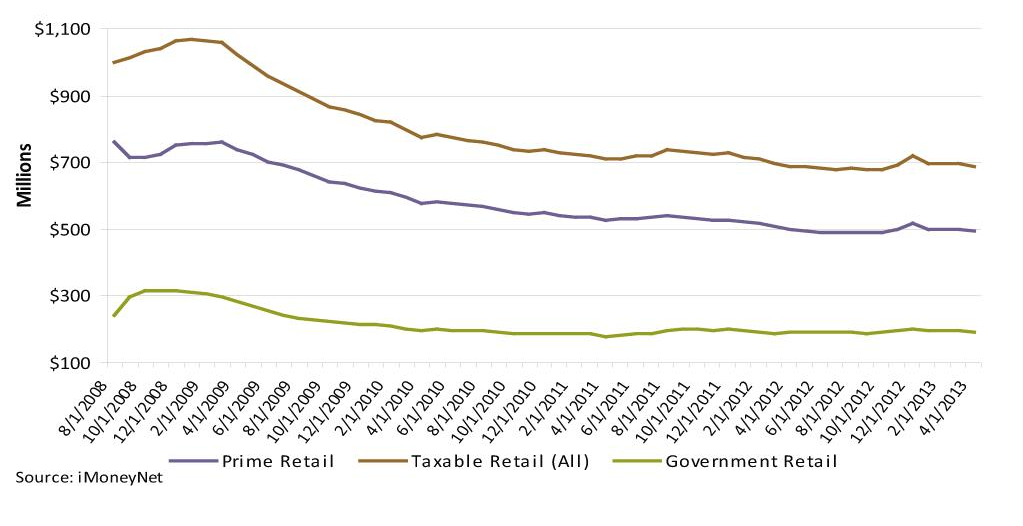

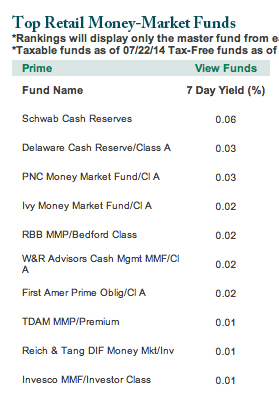
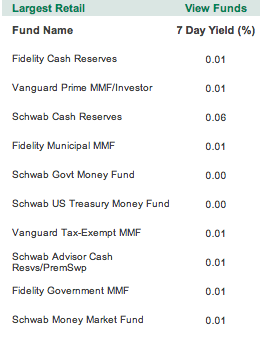
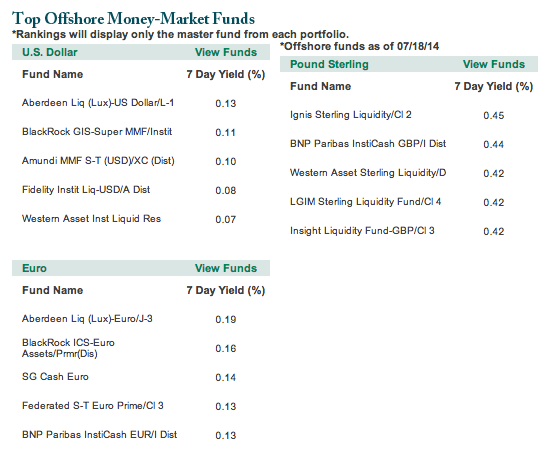
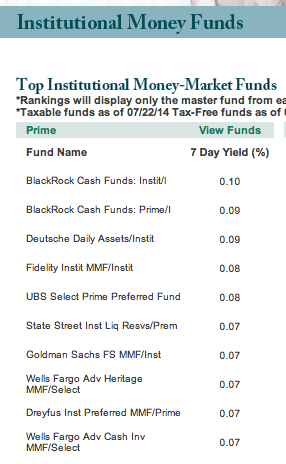
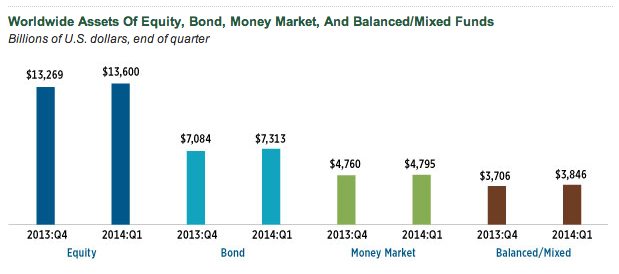


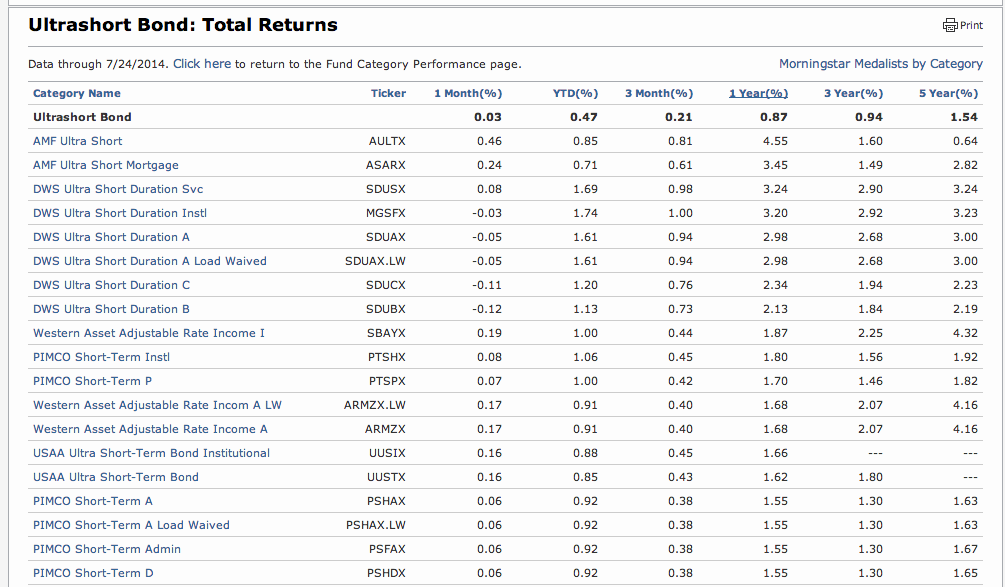
 2 Superior Growth Stocks to Buy Right Now If You have $1,000 to Invest
2 Superior Growth Stocks to Buy Right Now If You have $1,000 to Invest
